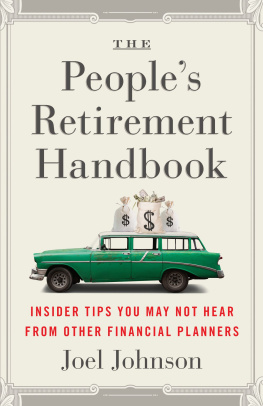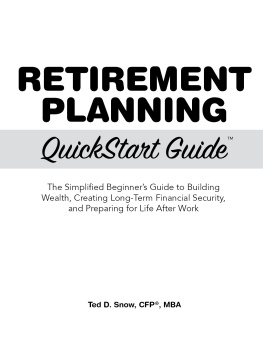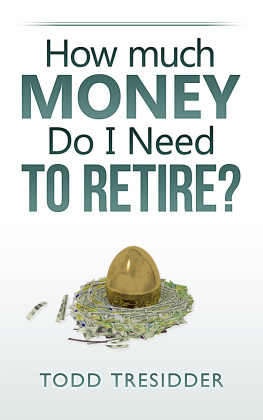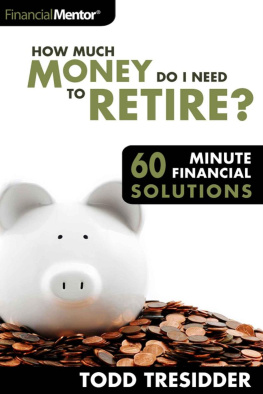Information provided in this book is general in nature and does not constitute specific financial advice. Each persons situation is different. Information, the economic environment, and tax laws can, and will, change without notice. Every effort has been made to ensure that the information provided is accurate. Individuals must not rely on this information to make a financial or investment decision. Before making any decision, the author and publisher recommend you consult a financial planner or tax advisor to take into account your particular investment objectives, financial situation, and individual needs. Past performance is not a guarantee of future results.
Certified Financial Planner Board of Standards Inc. (CFP Board) owns the certification marks CFP and CERTIFIED FINANCIAL PLANNER in the United States, which it authorizes use of by individuals who successfully complete CFP Boards initial and ongoing certification requirements.
Acknowledgments
I have to start by thanking my wonderful wife, Laura. From reading and editing early drafts to giving me advice on the cover, to keeping the house in order so I could spend time on this book, she was as important to this book getting done as I was. Thank you so much!
Mom and Dad, thank you for raising me with a sense of helping and serving others in life. All the volunteer work you have done in your lives has provided a great example for others to follow. If I ever needed anything, you were always there for me. Thank you!
A special thanks goes out to the people who helped me get into this professionEd OHara, Frank Nelson, and my other cohorts in those early financial planning classes. Your views, recommendations, and consistent encouragement allowed me to enter this profession in a way that aligned with my beliefs. Thank you!
To Dan Hoffman, my first boss in this profession. Im not sure Ill ever have a conversation with someone else that touches on prospects for the Cubs that year, instituting a barbell fixed - income strategy, and discussing the finer points of bond convexity. Thank you for your insights, help, and friendship all these years!
I want to thank all the financial planners in the National Association of Personal Financial Advisors (NAPFA) who have helped me over the years. Providing help, guidance, and encouragement to another is one of the greatest gifts of the human spirit. You live that every day in your thoughtful interactions with your clients and fellow professionals.
To the men and women who serve in our nations military. I know the sacrifices you make every day in your service to our country. Thank you to all those serving and especially your families that love and support you during difficult and often stressful times. My time in the military had a measurable and positive impact on my career and is a direct result of the military professionals I continue to interact with today.
Last, I want to thank all of my clients. Im honored and humbled that you have given me the opportunity to serve as your financial advisor. Your trust in my ability to help and guide you has given me a great sense of satisfaction and has allowed me to provide for my family. Thank you, and I look forward to each opportunity to serve you and your families in the future.
Introduction
The New Age of Retirement
When we think of retirement, many of us remember what it was like for our parents or grandparents. They probably worked most of their lives for the same company, and when they reached retirement, that company continued to take care of them in the form of a pension. The company had a board of directors who would decide how much to save and how to invest the pension fund in a way to produce a steady stream of income for the companys retired workers.
That world is mostly a thing of the past. Today, each of us is responsible for our retirement. We not only need to save up for retirement, but we also must figure out how to invest those savings so they will last the rest of our lives. While many companies will match whatever you save in your 401(k) retirement account (up to a point, of course), the trustees of the retirement plan who used to take care of the investments for you now just decide which investments to put into the companys 401(k) lineup of choices. Its up to you to determine how much to save and where to put that money, both before you retire and after.
Some of the most important decisions of your life are centered on taking care of your retirement. In a sense, you are at sea in a boat all by yourself, and you have to plot your own course. You have to know what direction to sail in and how long it will take to get to your destination. You have to learn how to forecast the weather and gauge the wind. Most importantly, you have to manage all those little disruptions that arise during the tripthe unexpected squalls, the occasional rough seas, and the doldrums, when there is no wind to help you, and it feels like youre going nowhere.
Challenges of Retirement
Retirement in the United States changed forever when Congress passed the Revenue Act of 1978, which created the first 401(k) plans. Two years later, the IRS gave employees a tax - free way to use salary deductions to fund their 401(k) plans. People loved this. They could transfer money from their gross pay to a retirement account and not have to pay any taxes on the income until years later when they retired and started withdrawing the funds.
Companies also loved 401(k) plans, which were cheaper and more predictable than defined benefit pension plans. Within a few years of the Revenue Act, many large companies switched from offering pension plans to making contributions to their employees 401(k) plans.
The US Department of Labor watched as that trend accelerated over the next several years. In 1980, for example, nearly a third of all Americans still had a defined benefit pension plan for their retirement and only one in twenty had one of the new 401(k) accounts. By 2010, the Department of Labor found that only about 2 percent of Americans had pensions and more than a third had a 401(k) plan as their primary source of funds for retirement. Nearly 80 percent of all US residents worked for an employer who offered a 401(k) plan. In just thirty years, the retirement landscape had changed dramatically.
The result is that today, if youre fifty - five or so and have been saving for retirement throughout your career, you must decide how to invest those savings so that you have a steady income that covers all your needs after you leave the workforce. Retirement used to be simple: work hard for thirty or forty years, then pick up your gold watch and collect your pension check every month. Now, even in retirement, your work isnt over. You still face difficult questions about how to nurture your nest egg so that it will continue to provide for you over the next thirty years or so.
Thats a tall order!
Myths about Retirement
To make matters even more challenging, many prospective retirees leave the workforce believing a number of myths about retirement. Lets take a look at some of those mistaken beliefs.









